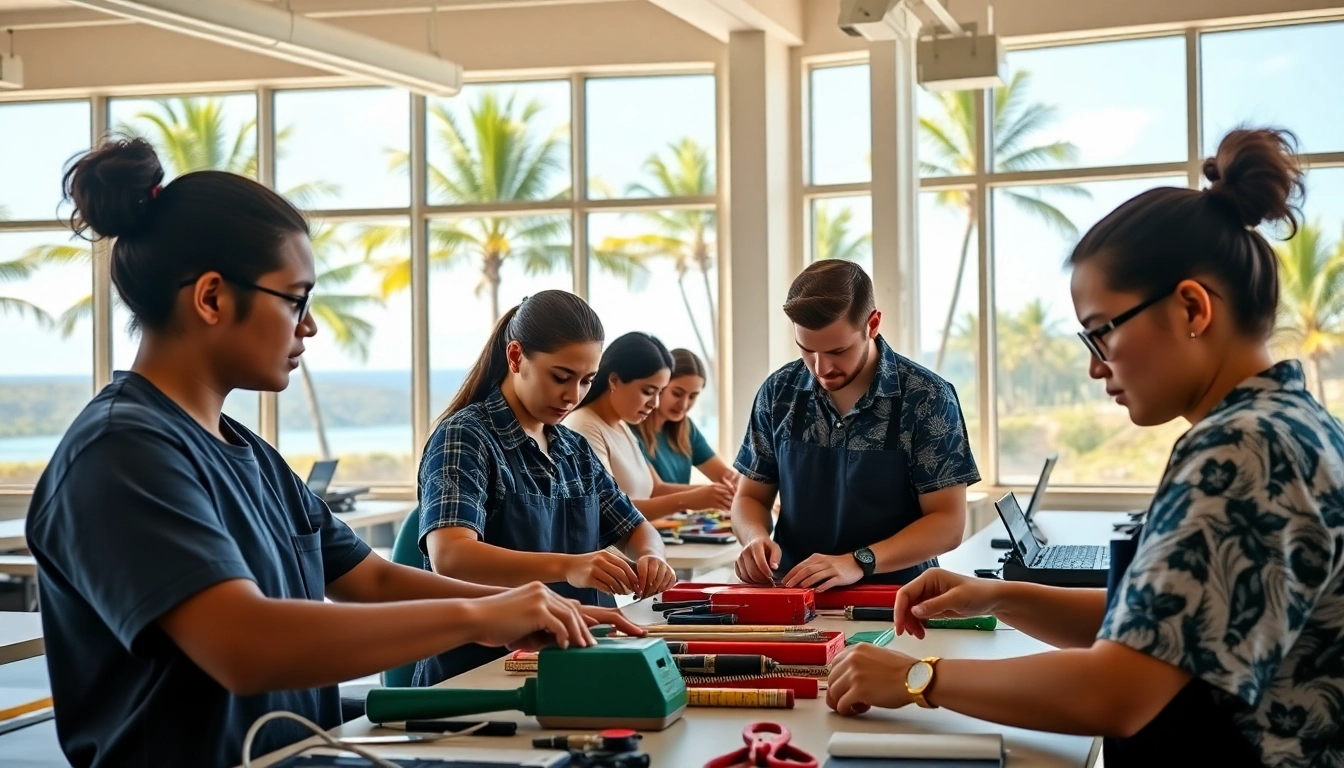Understanding Hawaii Trade Schools
What are Hawaii Trade Schools?
Hawaii trade schools play a crucial role in providing practical education focused on various skilled trades. These institutions offer specialized training programs designed to equip students with the necessary skills and knowledge to excel in various industries, including construction, healthcare, culinary arts, and more. Unlike traditional academic routes, trade schools emphasize hands-on experiences and real-world applications of trades, making them ideal for those who wish to enter the workforce quickly.
Trade schools can vary significantly in their offerings, ranging from short-term programs lasting a few months to longer programs that may take a couple of years to complete. These schools often collaborate with local businesses and industries, allowing students to gain valuable insights and connections as they prepare for their careers. For individuals seeking a direct path into lucrative job markets, enrolling in hawaii trade schools can be an excellent step towards achieving that goal.
Benefits of Enrolling in Hawaii Trade Schools
Enrolling in a trade school in Hawaii comes with numerous benefits that make this educational path appealing. One of the most significant advantages is the focused curriculum tailored to meet the specific demands of the job market. Students can often complete their training faster than traditional college programs, enabling them to enter the workforce sooner.
Trade schools also typically have lower tuition fees compared to traditional universities. This affordability can reduce financial burdens and allow students to avoid hefty student debts that can linger for years. Additionally, many trade schools maintain strong relationships with local employers, further enhancing students’ job placement opportunities upon graduation.
Furthermore, hands-on training allows students to develop practical skills that are highly valued in the job market. This experiential learning approach helps build confidence and competence, making graduates more desirable to potential employers. In Hawaii, where there is a constant demand for skilled labor, trade schools serve as a bridge connecting students to opportunities in various industries.
Types of Programs Offered
Hawaii trade schools offer a diverse range of programs catering to various fields of interest. Common programs include:
- Construction Trades: Programs focusing on carpentry, plumbing, electrical work, and HVAC (Heating, Ventilation, and Air Conditioning).
- Healthcare: Training for roles such as medical assistants, nursing aides, and dental hygienists.
- Culinary Arts: Courses that equip students with skills in cooking, baking, and hospitality management.
- Information Technology: Programs focused on computer networking, cybersecurity, and software development.
- Automotive Technology: Training in vehicle repair, maintenance, and service management.
These programs not only prepare students for immediate employment but also provide foundational skills that can lead to further advancement in their chosen careers.
Choosing the Right Hawaii Trade School
Key Factors to Consider
Selecting the right trade school is critical for a successful educational experience and career launch. Prospective students should consider several important factors before making their decision.
- Program Offerings: Ensure the school offers the specific trade programs that align with your career interests.
- Faculty Experience: Investigate the expertise of the instructors, as experienced professionals can provide valuable industry insights and mentorship.
- Facilities and Equipment: Check whether the school has up-to-date facilities and equipment that mirror real-world work environments.
- Class Size: Smaller class sizes often mean more personalized attention from instructors and better learning outcomes.
Accreditation and Reputation
Accreditation is another key element to examine when choosing a trade school. Accreditation ensures that the school meets certain educational standards, indicating a quality program. Attending an accredited school can also be beneficial when seeking federal financial aid and improves job prospects after graduation since employers often recognize accredited institutions as reputable.
In addition to accreditation, researching the school’s reputation through online reviews and testimonials can provide insights into the experiences of former students. A school with a positive reputation is more likely to have strong connections with local employers, further aiding students in job placement.
Location and Accessibility
The location of a trade school can also significantly impact a student’s experience. Consider the ease of commuting to the school and whether it is accessible by public transportation. Furthermore, the school’s location can affect internship and job opportunities within the local industry. Being situated close to employers or in a region with a high demand for specific trades can enhance job prospects for graduates.
Financial Aid and Tuition Options
Understanding Costs Associated with Hawaii Trade Schools
The costs associated with attending a trade school can vary widely based on the program, institution, and duration of study. Generally, trade school tuition is lower than that of traditional four-year universities. However, students should still budget for additional costs such as books, supplies, certifications, and potential living expenses.
It’s important to research all costs thoroughly before enrolling. Contacting the admissions office of the chosen trade school can help clarify tuition structures and any additional fees that may apply.
Scholarship Opportunities
Many trade schools offer scholarships to help offset tuition costs for eligible students. These scholarships can be based on various factors including academic performance, financial need, and specific demographic criteria. Organizations and foundations may also provide scholarship opportunities for students pursuing trades, so potential students should conduct research early to find and apply for available scholarships.
In addition, some employers offer scholarships or training assistance programs as part of their commitment to workforce development. Engaging with local businesses can uncover possibilities for financial assistance.
Loan Programs for Students
If scholarships and savings do not cover the total costs, students may consider taking out loans to finance their education. Several options are available, including federal student loans, private loans, and payment plan arrangements that allow students to pay tuition over time. Understanding loan terms, interest rates, and repayment plans is crucial before committing to any loan agreement to avoid potential financial pitfalls post-graduation.
Job Placement and Career Opportunities after Graduation
Industries with High Demand for Graduates
Hawaii’s labor market offers several steady industries that consistently seek skilled tradespeople. Key sectors include:
- Construction: A robust construction industry in Hawaii continuously needs electricians, plumbers, carpenters, and general laborers.
- Healthcare: With an aging population, healthcare professionals like medical assistants and nursing aides are in increasing demand.
- Hospitality and Tourism: The hospitality industry provides numerous job opportunities for chefs, restaurant managers, and service staff.
- Information Technology: As businesses grow increasingly reliant on technology, IT professionals are sought after for various roles.
Tips for Networking and Job Searches
Networking is an essential aspect of finding job opportunities post-graduation from trade schools. Participating in industry events, attending job fairs, and joining relevant professional associations can help build connections. Additionally, students should leverage social media platforms like LinkedIn to connect with alumni, industry professionals, and potential employers.
Internships and apprenticeships during school can provide valuable experience and further networking opportunities. Students should take advantage of any available job placement services offered by their trade schools, as these can connect them directly with employers seeking their specific skills.
Success Stories of Alumni from Hawaii Trade Schools
Hearing success stories from alumni can offer motivation and insight for current students. Many graduates have reported positive outcomes after completing their programs, including higher earning potential and job satisfaction. Alumni often share how their hands-on training prepared them for real-world challenges and helped them build successful careers in their chosen fields.
Showcasing alumni achievements can also enhance the reputation of a trade school and serve as marketing tools to prospective students considering enrollment. Schools may share testimonials, case studies, or profiles highlighting the career trajectories of successful graduates.
The Future of Vocational Education in Hawaii
Trends Shaping Hawaii Trade Schools
Vocational education in Hawaii is evolving to meet the changing demands of the workforce. One significant trend is the increasing incorporation of technology into education. Trade schools are integrating modern tools and software into their training modules, ensuring students are well-prepared for the technological advancements in their respective fields.
Additionally, there’s a growing emphasis on sustainability across trades. Schools are beginning to introduce green technologies and practices, particularly in construction and automotive programs, aligning education with environmental responsibility.
The Role of Technology in Trade Education
Technology is transforming trade education by enabling innovative teaching methods. Many trade schools are adopting blended learning models that combine traditional classroom instruction with online coursework. Virtual simulations and augmented reality are also being utilized to provide students with practical training scenarios that enhance their learning experience.
Moreover, technology equips students with skills that are not only relevant today but will also remain crucial as industries continue to evolve. For example, IT programs now include cyber security and cloud computing modules, responding to the increasing demand for such expertise.
How Trade Schools Adapt to Local Workforce Needs
Trade schools must remain responsive to the workforce needs of Hawaii’s economy. Schools often collaborate with local businesses to continuously assess the skills that are in demand. This collaboration ensures that the curriculum stays relevant and that students receive the training needed to meet local industry demands.
By building partnerships with employers, schools can also facilitate internships and job opportunities for students, creating a win-win situation where students gain experience and employers find equipped candidates ready to contribute.



